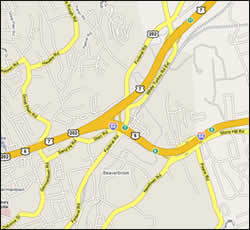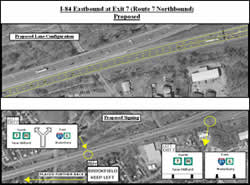FHWA Localized Bottleneck Reduction Program
Case Study
Printable Version [PDF 173KB]
You may need the Adobe® Reader® to view the PDF on this page.
Contact Information: Neil Spiller at Neil.Spiller@dot.gov
 Study Area (map "for placement only")
Study Area (map "for placement only")
Location – Danbury, Connecticut
I-84 eastbound at Exit 7 (Route 7 northbound) in Danbury, Connecticut.
Problem – Insufficient capacity at freeway diverge point
Congestion routinely existed on I-84 eastbound in advance of the I-84/Route 7 split. Traffic counts indicate that a significant percentage of traffic on I-84 eastbound exits onto Route 7 northbound. The existing lane configuration on I-84 in advance of Exit 7 consists of three travel lanes. At Exit 7, the left lane becomes an exit only lane onto Route 7, with the center and right lanes continuing as through lanes. This arrangement forces all traffic bound for Route 7 to maneuver into the left most lane prior to the exit, creating weaving conditions and bottlenecking as drivers move into the left lane to access the exit.
Solution – Re-stripe diverge area to better serve demand
ConnDOT and FHWA devised a low cost solution which involved re-striping the lanes within the diverge area to better serve demand and address the bottleneck and weaving problems that exist. The lanes on I-84 eastbound were reconfigured to allow the center lane to function as an option lane, where vehicles would have the option to exit or continue on I-84. It was determined that the existing pavement width in the vicinity of the ramp gore would accommodate the option lane, and it would tie in with the current lane configuration on the ramp, which included two lanes. The project required minor signing and striping revisions and some pavement modification. The work involved the removal of approximately 100 linear feet of existing pavement markings, installation of approximately 200 linear feet of pavement markings, the removal of two overhead directional signs, and the installation of two diagrammatic overhead directional signs. The bottleneck improvements are being incorporated into a larger interchange improvement project at I-84/Route 37 (Project 34-313), which will be advertised in June 2009. The cost associated with the bottleneck improvements is estimated to be $900,000.
 Proposed Lane Configuration
Proposed Lane Configuration
Lesson Learned
This project demonstrates how low-cost bottleneck improvements can make significant improvements in traffic flow.